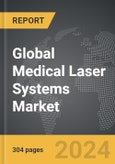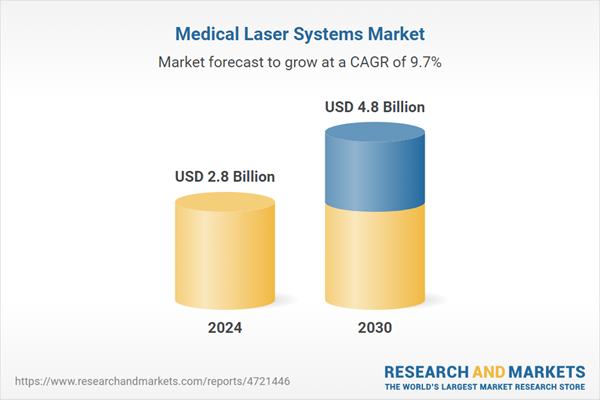The global market for Medical Laser Systems was valued at US$2.8 Billion in 2024 and is projected to reach US$4.8 Billion by 2030, growing at a CAGR of 9.7% from 2024 to 2030. This comprehensive report provides an in-depth analysis of market trends, drivers, and forecasts, helping you make informed business decisions. The report includes the most recent global tariff developments and how they impact the Medical Laser Systems market.
Continued innovation in laser technology has significantly enhanced its applicability in medical treatments. Improvements in the precision of laser equipment and its capacity to selectively target various tissues have expanded the array of procedures that can benefit from this technology. The global trend towards minimally invasive surgeries, which are preferred for their shorter hospital stays and quicker recovery periods, heavily relies on medical lasers for their precision and reduced physical impact. Furthermore, the burgeoning demand for cosmetic procedures worldwide is driving the expansion of medical laser systems. Lasers play a crucial role in aesthetic treatments like skin resurfacing, tattoo removal, and hair removal. Recent advancements have focused on incorporating enhanced safety features that adhere to stringent clinical safety standards, with modern lasers featuring sophisticated real-time monitoring systems to regulate energy levels effectively and safely, alongside additional safety mechanisms such as skin cooling systems, contact sensors, and automatic shut-offs to minimize risks and boost patient confidence.
Looking to the future, the integration of AI with medical laser technology is expected to refine and expand the capabilities of these systems through predictive modeling and enhanced cross-modality integration. AI's potential to predict patient responses to various treatment settings could allow for more customized treatment plans, enhancing the precision of laser surgeries by optimizing settings in real-time and providing instantaneous feedback to surgeons. The addition of robotics promises even greater precision in laser surgeries, while the integration with other diagnostic modalities like imaging and spectroscopy could offer a more comprehensive evaluation of treatment areas, improving procedural decisions and outcomes. Additionally, the trend towards developing portable and compact laser systems is making these treatments more accessible and convenient, particularly in clinic and office settings. The advancement of green laser technology, especially in applications like cataract and glaucoma surgeries, is also notable for its improved visibility and reduced tissue damage risk.
Segments: Product Type (Diode Laser Systems, Solid State Laser Systems, Gas Laser Systems, Other Product Types); Application (Dermatology, Ophthalmology, Dentistry, Other Applications).
Geographic Regions/Countries: World; United States; Canada; Japan; China; Europe (France; Germany; Italy; United Kingdom; Spain; Russia; and Rest of Europe); Asia-Pacific (Australia; India; South Korea; and Rest of Asia-Pacific); Latin America (Argentina; Brazil; Mexico; and Rest of Latin America); Middle East (Iran; Israel; Saudi Arabia; United Arab Emirates; and Rest of Middle East); and Africa.
The analysts continuously track trade developments worldwide, drawing insights from leading global economists and over 200 industry and policy institutions, including think tanks, trade organizations, and national economic advisory bodies. This intelligence is integrated into forecasting models to provide timely, data-driven analysis of emerging risks and opportunities.
Medical Laser Systems
- Key Trends and Drivers
Medical laser systems are increasingly integral to a wide array of healthcare procedures, spanning from intricate surgical operations to aesthetic enhancements. The precise control afforded by these systems, along with their ability to minimize trauma and hasten recovery, positions them as a favored technology in contemporary medical settings. The market for medical laser systems is set to experience robust growth, fueled by ongoing technological advancements, a surge in minimally invasive procedures, and a rising demand for cosmetic treatments. Innovations such as the integration of AI and robotics, the development of portable laser systems, and an emphasis on patient safety are pivotal trends steering this sector. As these technologies evolve, they are poised to broaden the scope of medical treatments, offering solutions that are more efficient, safer, and more patient-centric.Continued innovation in laser technology has significantly enhanced its applicability in medical treatments. Improvements in the precision of laser equipment and its capacity to selectively target various tissues have expanded the array of procedures that can benefit from this technology. The global trend towards minimally invasive surgeries, which are preferred for their shorter hospital stays and quicker recovery periods, heavily relies on medical lasers for their precision and reduced physical impact. Furthermore, the burgeoning demand for cosmetic procedures worldwide is driving the expansion of medical laser systems. Lasers play a crucial role in aesthetic treatments like skin resurfacing, tattoo removal, and hair removal. Recent advancements have focused on incorporating enhanced safety features that adhere to stringent clinical safety standards, with modern lasers featuring sophisticated real-time monitoring systems to regulate energy levels effectively and safely, alongside additional safety mechanisms such as skin cooling systems, contact sensors, and automatic shut-offs to minimize risks and boost patient confidence.
Looking to the future, the integration of AI with medical laser technology is expected to refine and expand the capabilities of these systems through predictive modeling and enhanced cross-modality integration. AI's potential to predict patient responses to various treatment settings could allow for more customized treatment plans, enhancing the precision of laser surgeries by optimizing settings in real-time and providing instantaneous feedback to surgeons. The addition of robotics promises even greater precision in laser surgeries, while the integration with other diagnostic modalities like imaging and spectroscopy could offer a more comprehensive evaluation of treatment areas, improving procedural decisions and outcomes. Additionally, the trend towards developing portable and compact laser systems is making these treatments more accessible and convenient, particularly in clinic and office settings. The advancement of green laser technology, especially in applications like cataract and glaucoma surgeries, is also notable for its improved visibility and reduced tissue damage risk.
Report Scope
The report analyzes the Medical Laser Systems market, presented in terms of units. The analysis covers the key segments and geographic regions outlined below.Segments: Product Type (Diode Laser Systems, Solid State Laser Systems, Gas Laser Systems, Other Product Types); Application (Dermatology, Ophthalmology, Dentistry, Other Applications).
Geographic Regions/Countries: World; United States; Canada; Japan; China; Europe (France; Germany; Italy; United Kingdom; Spain; Russia; and Rest of Europe); Asia-Pacific (Australia; India; South Korea; and Rest of Asia-Pacific); Latin America (Argentina; Brazil; Mexico; and Rest of Latin America); Middle East (Iran; Israel; Saudi Arabia; United Arab Emirates; and Rest of Middle East); and Africa.
Key Insights:
- Market Growth: Understand the significant growth trajectory of the Diode Laser Systems segment, which is expected to reach US$1.6 Billion by 2030 with a CAGR of a 10.2%. The Solid State Laser Systems segment is also set to grow at 11.9% CAGR over the analysis period.
- Regional Analysis: Gain insights into the U.S. market, valued at $743.4 Million in 2024, and China, forecasted to grow at an impressive 13.8% CAGR to reach $1.1 Billion by 2030. Discover growth trends in other key regions, including Japan, Canada, Germany, and the Asia-Pacific.
Why You Should Buy This Report:
- Detailed Market Analysis: Access a thorough analysis of the Global Medical Laser Systems Market, covering all major geographic regions and market segments.
- Competitive Insights: Get an overview of the competitive landscape, including the market presence of major players across different geographies.
- Future Trends and Drivers: Understand the key trends and drivers shaping the future of the Global Medical Laser Systems Market.
- Actionable Insights: Benefit from actionable insights that can help you identify new revenue opportunities and make strategic business decisions.
Key Questions Answered:
- How is the Global Medical Laser Systems Market expected to evolve by 2030?
- What are the main drivers and restraints affecting the market?
- Which market segments will grow the most over the forecast period?
- How will market shares for different regions and segments change by 2030?
- Who are the leading players in the market, and what are their prospects?
Report Features:
- Comprehensive Market Data: Independent analysis of annual sales and market forecasts in US$ Million from 2024 to 2030.
- In-Depth Regional Analysis: Detailed insights into key markets, including the U.S., China, Japan, Canada, Europe, Asia-Pacific, Latin America, Middle East, and Africa.
- Company Profiles: Coverage of players such as AMD Lasers, AngioDynamics Inc., Bausch & Lomb Inc., BIOLASE Inc., Biolitec AG and more.
- Complimentary Updates: Receive free report updates for one year to keep you informed of the latest market developments.
Some of the 103 companies featured in this Medical Laser Systems market report include:
- AMD Lasers
- AngioDynamics Inc.
- Bausch & Lomb Inc.
- BIOLASE Inc.
- Biolitec AG
- Carl Zeiss Meditec AG
- Cutera Inc.
- Danaher
- Hologic Inc.
- Lumenis Ltd.
- Nidek Co. Ltd.
- Spectranetics Corporation
- Syneron Cadila
- Topcon Corporation
Tariff Impact Analysis: Key Insights for 2025
Global tariff negotiations across 180+ countries are reshaping supply chains, costs, and competitiveness. This report reflects the latest developments as of April 2025 and incorporates forward-looking insights into the market outlook.The analysts continuously track trade developments worldwide, drawing insights from leading global economists and over 200 industry and policy institutions, including think tanks, trade organizations, and national economic advisory bodies. This intelligence is integrated into forecasting models to provide timely, data-driven analysis of emerging risks and opportunities.
What’s Included in This Edition:
- Tariff-adjusted market forecasts by region and segment
- Analysis of cost and supply chain implications by sourcing and trade exposure
- Strategic insights into geographic shifts
Buyers receive a free July 2025 update with:
- Finalized tariff impacts and new trade agreement effects
- Updated projections reflecting global sourcing and cost shifts
- Expanded country-specific coverage across the industry
Table of Contents
I. METHODOLOGYII. EXECUTIVE SUMMARY2. FOCUS ON SELECT PLAYERSIII. MARKET ANALYSISCANADAITALYSPAINRUSSIAREST OF EUROPESOUTH KOREAREST OF ASIA-PACIFICARGENTINABRAZILMEXICOREST OF LATIN AMERICAIRANISRAELSAUDI ARABIAUNITED ARAB EMIRATESREST OF MIDDLE EASTIV. COMPETITION
1. MARKET OVERVIEW
3. MARKET TRENDS & DRIVERS
4. GLOBAL MARKET PERSPECTIVE
UNITED STATES
JAPAN
CHINA
EUROPE
FRANCE
GERMANY
UNITED KINGDOM
ASIA-PACIFIC
AUSTRALIA
INDIA
LATIN AMERICA
MIDDLE EAST
AFRICA
Companies Mentioned (Partial List)
A selection of companies mentioned in this report includes, but is not limited to:
- AMD Lasers
- AngioDynamics Inc.
- Bausch & Lomb Inc.
- BIOLASE Inc.
- Biolitec AG
- Carl Zeiss Meditec AG
- Cutera Inc.
- Danaher
- Hologic Inc.
- Lumenis Ltd.
- Nidek Co. Ltd.
- Spectranetics Corporation
- Syneron Cadila
- Topcon Corporation
Table Information
| Report Attribute | Details |
|---|---|
| No. of Pages | 304 |
| Published | April 2025 |
| Forecast Period | 2024 - 2030 |
| Estimated Market Value ( USD | $ 2.8 Billion |
| Forecasted Market Value ( USD | $ 4.8 Billion |
| Compound Annual Growth Rate | 9.7% |
| Regions Covered | Global |









